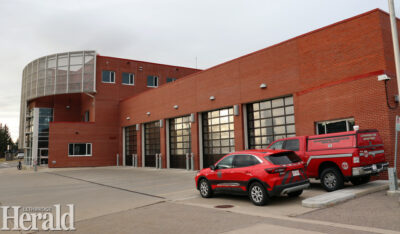SPC gives support to Fire and Emergency Services hiring of four medical supervisors
By Al Beeber - Lethbridge Herald on November 14, 2024.
 Herald photo by Al Beeber
The downtown fire hall is seen in this photo. City council acting as Economic and Finance SPC on Wednesday gave its support to four full-time medical supervisor positions which have been approved in the LFES new contract with Alberta Health Services.
Herald photo by Al Beeber
The downtown fire hall is seen in this photo. City council acting as Economic and Finance SPC on Wednesday gave its support to four full-time medical supervisor positions which have been approved in the LFES new contract with Alberta Health Services.LETHBRIDGE HERALDabeeber@lethbridgeherald.com
The Economic Standing Policy Committee of Lethbridge city council on Wednesday unanimously gave its blessing to the hiring of four full-time medical supervisors by the Lethbridge Fire and Emergency Services.
Money for the hirings is already contained in the contract LFES signed with Alberta Health Services this year and the SPC which consists of the mayor and all council members was simply being asked by Fire and EMS chief Greg Adair to give its support.
The first contract signed with AHS to provide EMS services here was signed in 2009 and for the past 16 years station captains have been responsible for providing EMS supervision.
While that system worked well, a report to the SPC said the model started to degrade in 2014 when the second contract was signed. That contract added four 12-hour ambulances that didn’t align with the LFES shift model which operates with 10-hour shifts. The new contract model requires ambulances to operate on 12 hour rotations.
While the change from the traditional shift schedule improved coverage to meet peak-time EMS demands, the report says it created a greater separation between EMS staff and captain-level supervision. Two more 12-hour ambulances were added last year which also don’t align with the traditional shift rotation.
Adair told the SPC the four positions are “boots on the ground” ones.
The fire chief said in 2022 the LFES provided to council its required operational needs and staffing models and talked about the need to move toward a parallel fire integrated EMS service away from the traditional fire/EMS services.
In April 2022, council directed the LFES to negotiate a financially responsible EMS contracted that supports both Fire and EMS, which has been accomplished, said Adair.
The four FTE medical supervisors “will ensure public safety, operational support and help maintain our current service levels,” said Adair. The supervisors will help at Chinook Regional Hospital to ensure resources get out to the community quicker and they’ll also help LFES keep resources here which the department struggles with due to resources being requested by other communities.
“Our medical supervisors can help meet our operational workload demands,” Adair said.
In 2009 when the first EMS contract was signed, the department was doing about 9,300 EMS call volumes annually. By 2023, that volume had risen to more than 26,000 calls.
“We’ve seen a significant increase since we first signed our EMS contract back in 2009,” he said.
EMS crews were away from their station nearly three times more in 2023 than in 2009 and six of 10 ambulances don’t follow the Fire operations schedule.
Complexities continue to grow with long distance transfers, responses to calls outside of the city, the EMS dispatch moving to Calgary, and other factors.
Average EMS calls were 2,325 per ambulance in 2009 and grew to 3,714 in 2023.
Fire volume calls have nearly doubled from just over 1,500 in 2009 to nearly 3,000 in 2023.
The medical supervisors “will be able to help us manage those increased operational workloads,” the chief added.
Those medical supervisors will also “help provide cost containment and staff support. This is significant – we need to stabilize our increased operational costs we are experiencing in our short-term disability, long-term disability, WCB and psychological costs,” he said, pointing out that disabilities in 2009 cost $2,400 annually per individual, a cost that has risen to $6,100 annually per person.
In 2009,spending on short and long-term disability was $340,000 annually and in 2024, more than $1.4 million was being spent.
“We need to help stabilize that cost and through our medical supervisors we’ll be able to help provide the support required for our EMS men and women that will help stabilize those costs,” Adair added.
WCB and psychological costs have also risen. In 2009 those costs were nearly zero while WCB costs are up over $300,000 annually now and psychological costs are over $73,000 annually, the chief said.
The LFES also faced an overtime cost of $700,000 in 2009; in 2023 that cost was more than $1.1 million.
“So through proper supervision, we hope to reduce the overtime costs,” said Adair.
In 2009, LFES had 148 employees, in 2025 the department is anticipating 258 on staff. As part of budget initiative N-26, the department is in the process of hiring 13 FTEs to support fire operations.
In 2009, the department had 40 dedicated EMS staff and in 2024, it has 78.
To manage that team of people, Adair said there is an administrative team providing support of 29 individuals. When comparing itself to other jurisdictions, Red Deer has 41, Strathcona 48 and Fort McMurray 52.
But Lethbridge is the busiest EMS service out of its comparators, he said. The supervisors will allow LFES to help reduce over-capacity pressures being faced by LFES administration, he added.
29-28


